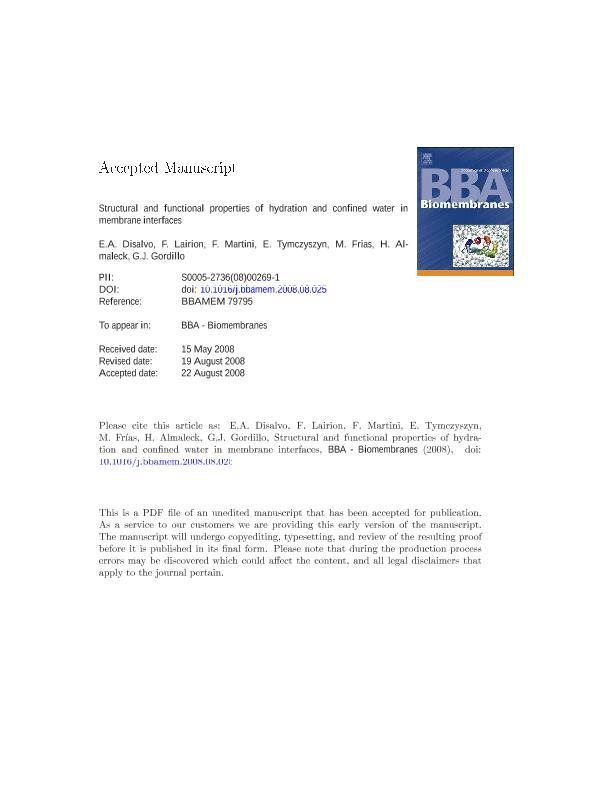Artículo
Structural and functional properties of hydration and confined water in membrane interfaces
Disalvo, Edgardo Anibal ; Lairion, Fabiana Norma; Martini, María Florencia
; Lairion, Fabiana Norma; Martini, María Florencia ; Tymczyszyn, Emma Elizabeth
; Tymczyszyn, Emma Elizabeth ; Frías, María de los Ángeles
; Frías, María de los Ángeles ; Almaleck, Samuel Hugo; Gordillo, Gabriel Jorge
; Almaleck, Samuel Hugo; Gordillo, Gabriel Jorge
 ; Lairion, Fabiana Norma; Martini, María Florencia
; Lairion, Fabiana Norma; Martini, María Florencia ; Tymczyszyn, Emma Elizabeth
; Tymczyszyn, Emma Elizabeth ; Frías, María de los Ángeles
; Frías, María de los Ángeles ; Almaleck, Samuel Hugo; Gordillo, Gabriel Jorge
; Almaleck, Samuel Hugo; Gordillo, Gabriel Jorge
Fecha de publicación:
12/2008
Editorial:
Elsevier Science
Revista:
Biochimica et Biophysica Acta - Biomembranes
ISSN:
0005-2736
Idioma:
Inglés
Tipo de recurso:
Artículo publicado
Clasificación temática:
Resumen
The scope of the present review focuses on the interfacial properties of cell membranes that may establish a link between the membrane and the cytosolic components. We present evidences that the current view of the membrane as a barrier of permeability that contains an aqueous solution of macromolecules may be replaced by one in which the membrane plays a structural and functional role. Although this idea has been previously suggested, the present is the first systematic work that puts into relevance the relation water-membrane in terms of thermodynamic and structural properties of the interphases that cannot be ignored in the understanding of cell function. To pursue this aim, we introduce a new definition of interphase, in which the water is organized in different levels on the surface with different binding energies. Altogether determines the surface free energy necessary for the structural response to changes in the surrounding media. The physical chemical properties of this region are interpreted in terms of hydration water and confined water, which explain the interaction with proteins and could affect the modulation of enzyme activity. Information provided by several methodologies indicates that the organization of the hydration states is not restricted to the membrane plane albeit to a region extending into the cytoplasm, in which polar head groups play a relevant role. In addition, dynamic properties studied by cyclic voltammetry allow one to deduce the energetics of the conformational changes of the lipid head group in relation to the head-head interactions due to the presence of carbonyls and phosphates at the interphase. These groups are, apparently, surrounded by more than one layer of water molecules: a tightly bound shell, that mostly contributes to the dipole potential, and a second one that may be displaced by proteins and osmotic stress. Hydration water around carbonyl and phosphate groups may change by the presence of polyhydroxylated compounds or by changing the chemical groups esterified to the phosphates, mainly choline, ethanolamine or glycerol. Thus, surface membrane properties, such as the dipole potential and the surface pressure, are modulated by the water at the interphase region by changing the structure of the membrane components. An understanding of the properties of the structural water located at the hydration sites and the functional water confined around the polar head groups modulated by the hydrocarbon chains is helpful to interpret and analyze the consequences of water loss at the membranes of dehydrated cells. In this regard, a correlation between the effects of water activity on cell growth and the lipid composition is discussed in terms of the recovery of the cell volume and their viability. Critical analyses of the properties of water at the interface of lipid membranes merging from these results and others from the literature suggest that the interface links the membrane with the aqueous soluble proteins in a functional unit in which the cell may be considered as a complex structure stabilized by water rather than a water solution of macromolecules surrounded by a semi permeable barrier.
Archivos asociados
Licencia
Identificadores
Colecciones
Articulos(INQUIMAE)
Articulos de INST.D/QUIM FIS D/L MATERIALES MEDIOAMB Y ENERGIA
Articulos de INST.D/QUIM FIS D/L MATERIALES MEDIOAMB Y ENERGIA
Articulos(OCA HOUSSAY)
Articulos de OFICINA DE COORDINACION ADMINISTRATIVA HOUSSAY
Articulos de OFICINA DE COORDINACION ADMINISTRATIVA HOUSSAY
Articulos(SEDE CENTRAL)
Articulos de SEDE CENTRAL
Articulos de SEDE CENTRAL
Citación
Disalvo, Edgardo Anibal; Lairion, Fabiana Norma; Martini, María Florencia; Tymczyszyn, Emma Elizabeth; Frías, María de los Ángeles; et al.; Structural and functional properties of hydration and confined water in membrane interfaces; Elsevier Science; Biochimica et Biophysica Acta - Biomembranes; 1778; 12; 12-2008; 2655-2670
Compartir
Altmétricas



